
95% of researchers rate our articles as excellent or good
Learn more about the work of our research integrity team to safeguard the quality of each article we publish.
Find out more
REVIEW article
Front. Phys. , 18 January 2024
Sec. High-Energy and Astroparticle Physics
Volume 12 - 2024 | https://doi.org/10.3389/fphy.2024.1317659
This article is part of the Research Topic Science And Technology In Deep Underground Laboratories View all 19 articles
This overview provides a comprehensive insight into Callio Lab, a versatile multidisciplinary research platform, by describing the events and actions that have led to the development of the project-based, pay-by-service approach to organizing and economically running the research activities, a mandatory approach for a platform operating without governmental funding. The research platform has a maximum depth of 1.4 km underground, equivalent to approximately 4,100 m of water equivalent (m.w.e.). The flat-overburden mine configuration of Callio Lab minimizes cosmic-ray background interference, making it an ideal setting for low-background experiments, particularly in neutrino and dark matter research. The main-level galleries, with dimensions up to 12 m wide, 30–40 m long, and 8 m tall, provide ample space for research activities, with the potential for even more extensive galleries based on Laguna design studies. Callio Lab has a history with several small and medium-scale cosmic ray and low-background experiments. This overview highlights the site’s inherent characteristics, revealing promising opportunities for high-energy and applied physics research and applications across various scientific domains.
Since 1962, the Pyhäsalmi Mine in central Finland has been notable for scientific and technological advancements. Rich in zinc, copper, and pyrite, the underground extraction continued until August 2022, surpassing 60 years. Originally slated to close in the late 1990s, the discovery of additional ore beneath the existing mine extended its life by over two decades. The eventual closure of the mine has prompted the nearby Pyhäjärvi community to ponder the future beyond mining.
Underground particle physics was identified as key to revitalizing the Pyhäsalmi mine. In 1999, the University of Oulu, aided by Finnish universities including the University of Jyväskylä as a scientific advisor, founded the Centre for Underground Physics in Pyhäsalmi (CUPP) [1]. Aiming to make the site a leading Finland´s premier international research infrastructure, the team collaborated on neutrino experiment planning, positioning Pyhäsalmi as a candidate for European GLACIER, LENA, and MEMPHYS detectors [2]. The feasibility of candidate sites was evaluated during the European Commission FP7 program -funded LAGUNA (Large Apparatus for Grand Unification and Neutrino Astronomy) and subsequent LAGUNA-LBNO (Long Base Line Neutrino Observatory) Design Studies [2–5]. Finland was identified as the ideal location to host all the proposed experiments. However, none of these experiments were ultimately constructed in Europe. While the design studies were ongoing, CUPP began its legacy with underground physics experiments, including cosmic ray experiments such as Muons UnderGround (MUG, 2000–2002 [1,6]), Movable Underground Detector (MUD, 2004–2005 [7]) and Experiment with MultiMuon Array (EMMA, 2005–2018 [8,9]). The low background experiment C14 (2016- [10]) is used to study liquid scintillators’ 14C/12C ratios. These experiments have shown that Pyhäsalmi, Finland, is where scientific experiments can be conducted.
In 2015, with the Laguna LBNO’s outcomes indicating a shift away from major physics experiments at Pyhäsalmi Mine, CUPP underwent a significant transition. It evolved from a dedicated particle physics research facility into Callio Lab, a multidisciplinary research center, to broaden its scientific scope and future potential [11]. The establishment of Callio Lab has broadened onsite research to encompass particle physics and geosciences, among other fields, including deep geothermal [12], deep bedrock microbiological research [13,14] to underground food production [15], and remote sensing [16,17], with more to come.
Callio Lab’s collaboration has enhanced its role in Finnish and European research, exemplified by joining the European Plate Observation System (EPOS), which integrated it into broader Finnish, Nordic, and European research networks [18]. Current projects cherish the Pyhäsalmi mine’s history as a leading technology adapter and test site for future mining technologies. Current Horizon-funded projects include H2020 GoldenEye [19] and Horizon Europe MINE.IO [20], which benefit from the underground and above-ground infrastructure.
Callio Lab is one of the northernmost underground research infrastructures in Europe. It is in the Northern Ostrobothnia, Finland, in the town of Pyhäjärvi. It utilizes the mining environment of Pyhäsalmi Mine Oy. The mine infrastructure consists of a 1.4 km (∼4,100 m water equivalent) deep underground mine and surface areas, including two open pits, an industrial area, and a 250 ha tailings area. The research activities benefit from the whole mine site, not just the underground.
The geographical coordinates are N 63.6593, E 26.0419 (WGS 84). It is located near the intersection of two main roads, E4 and VT27. There are three regional airports within a 2-h drive, and the Helsinki-Vantaa airport is only 5 hours away. The mine site can also be accessed by cargo train from the Ylivieska—Iisalmi rail connection. See Figure 1 for illustration.
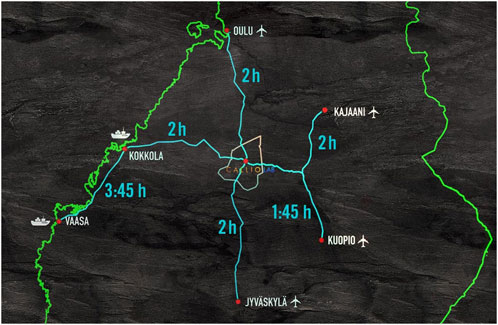
FIGURE 1. Alt Text Finnish road network. The Pyhäsalmi mine, and thus Callio Lab research environment and CALLIO—Mine for Business, is easy to reach whether arriving by car, train, or plane. Picture by Callio Lab.
The organizational structure at the Pyhäsalmi mine site involves three major entities. The aforementioned Callio Lab, coordinated by the University of Oulu´s Kerttu Saalasti Institute, facilitates scientific activities at the site utilizing both underground and surface infrastructure. Callio Lab operates on a project-based, pay-by-use approach, minimizing infrastructure costs. The Pyhäsalmi Mine Oy owns the mine site and is responsible for closure activities and safety monitoring. Pyhäjärven Callio [21], established by the Pyhäjärvi town in 2017, oversees the mine’s repurposing into an industrial and energy park, including the key development project Pyhäsalmi Pumped Hydro Energy Storage (PPHES), which alone would be big enough to allow the future upkeep and development of the mine site [22] For more information see, e.g., [23].
Callio Lab, like other underground laboratories, provides support services for scientific activities. As Callio Lab operates in a mining environment, there are clean rooms or no radioactivity screening facilities like in more established underground laboratories such as Gran Sasso and Canfranc [24]. However, what the Pyhäsalmi site has over other laboratories is a flat overburden of ∼4,100 m water equivalent (m.w.e.) deep underground infrastructure, with the possibility to excavate and equip new underground tunnels and galleries, also at hundred-meter scales [25]. To support the scientific activities, Callio Lab staff can operate in many roles: facilitator of experiments [19,26], onsite operator of scientific instruments [27,28], or developer of needed infrastructure [29]in cooperation with the Pyhäjärven Callio [30].
Safety is paramount in every operation, whether underground, on the surface, or in the airspace above. All the pilots, trials, and experiments need safety documentation and risk analysis to evaluate the activity’s safety and its effects on overall safety. Additionally, Callio Lab can provide various data sets, including ground truthing data for air and satellite studies and geological and geochemical data from local sources or national data repositories.
The site offers advanced connectivity and data security, crucial for testing and research. It features a fast wireless network alongside optical cabling for high-speed data transfer. Secure remote operations are enabled through VPN, supporting everything from drones to mining equipment. An industrial 5G network facilitates high data flow and mobile control, while the surrounding area is covered by public 3G and 4G networks [31,32].
The Pyhäsalmi mine’s surface area, spanning several hundred hectares See Figure 2., includes a main industrial zone with a beneficiation plant, open pits, and a direct railway line. Accompanying facilities include offices, workshops, and a logistics center. Its varied topography and 250-ha tailings area are ideal for Earth Observation data verification and support vertical take-offs for helicopters and drones. An airfield nearby facilitates data gathering via fixed-wing platforms [32].
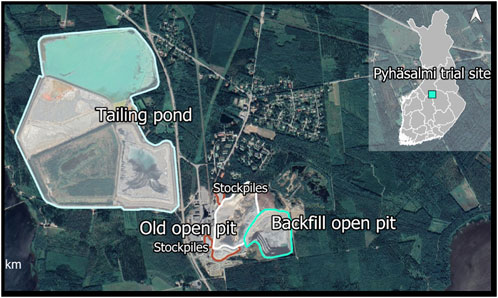
FIGURE 2. Alt Text Pyhäsalmi Mine Aerial. Callio Lab’s research environment is not limited to the underground but utilizes the whole industrial area for various research purposes. Picture by second author.
The Pyhäsalmi mine’s underground infrastructure expands over 100 km of tunnels and galleries. It features fast elevator access, an 11 km long vehicle incline, advanced ventilation, and a comprehensive safety system, including refuge chambers and a two-way radiophone network. The elevator takes 2.5 min from the surface to the main level at 1,410 m. Figure 3 shows the industrial mine elevator. The incline’s crosssection is spacious enough (see Figure 4 for illustration) to transport everything safely, from mining equipment to 20-foot sea containers [32].
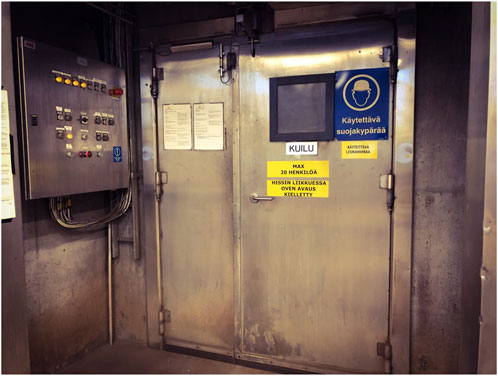
FIGURE 3. Alt Text Elevator Shaft. Access to the bottom of the mine takes less than 3 min by elevator. The journey is 1.4 km long. Picture by the second author.
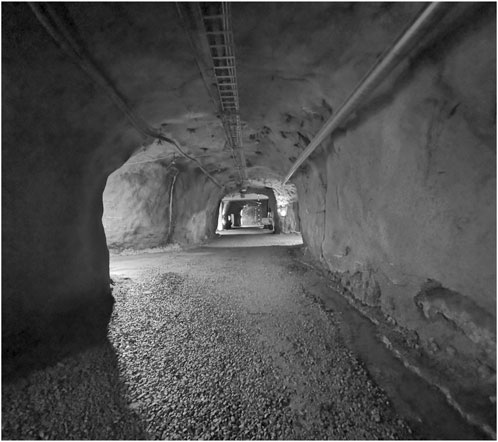
FIGURE 4. Alt Text Tunnel Cross-Section. The tunnel cross-section in the old part of the mine is roughly 5 × 5 m, allowing the transportation of mining equipment and up to 20′ marine containers. Picture by the first author.
The ventilation and water pumping are crucial for safety, managed via a Supervisory Control and Data Acquisition (SCADA) computer system that monitors air quality and alerts for any oxygen or carbon dioxide level deviations. The mine’s operational areas maintain an average temperature of 22°–28 °C and a humidity level of 30%–70%, achieved by continuously blowing fresh air from the surface and distributing it through the mine using auxiliary fans and ducting.
The main level of the Pyhäsalmi mine, at a depth of 1,410 m, prioritizes safety with a room for entire shifts, an ambulance, and transport for rescue teams. It features refuge chambers and a communication network for safety and open dialogue. This level includes an extensive maintenance facility, the world’s deepest sauna, a restaurant for 100 people, and comprehensive social amenities. The maintenance area has extensive storage, workshops, and parking, supporting the mines’ and Callio Lab´s operational needs [11].
The Pyhäsalmi mine includes specialized labs like the underground rescue and training center at 400 m depth (Lab 6) for high-risk training, including fire extinguishing and search and rescue in low visibility. Level 660 (Lab 4) focuses on underground farming technologies and mining machinery testing. Other labs, such as Lab 1*, 2, 3*, and 5, cater to varied projects, with Lab 5 currently hosting physics experiments. Decommissioned labs, marked with *, can be reactivated for new activities. See Figure 5 for the locations of labs within the Pyhäsalmi mine.
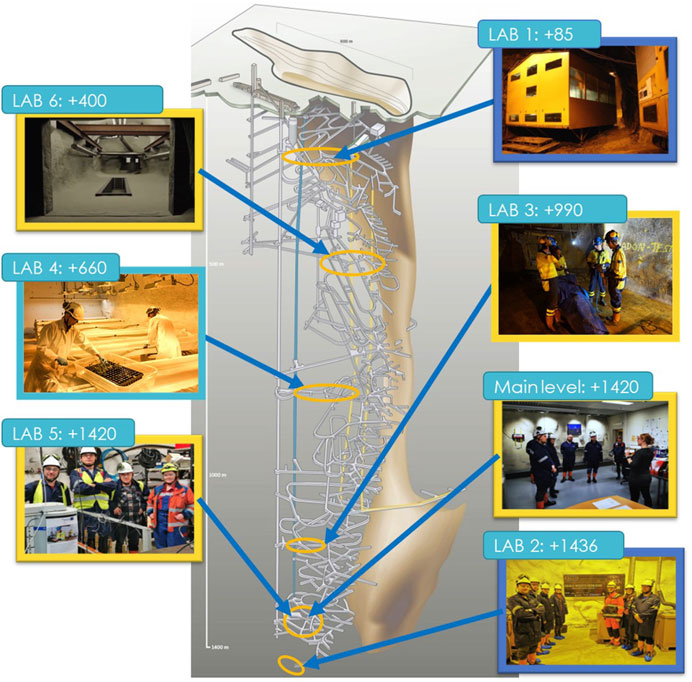
FIGURE 5. Alt Text Axonometric View With Lab Locations. Axonometric view of the Pyhäsalmi Mine and its ore body. The old orebody was carrot-shaped down to 990 m, and the new mine was from 990 m down to 1,400 m. Picture by Callio Lab.
In physics, ‘overburden’ refers to the material layer above a specific point underground, such as a mine tunnel, and is measured in meters of water equivalent (m.w.e.). Geologically, it includes soil and rock layers. Surface features, composed of soil and bedrock, are monitored using laser scanning, producing digital elevation models with a 2 × 2 meter resolution [33]. Thus, the characteristics and changes in topography and their effect on overburden can be measured accurately; see Figure 6 for more details.
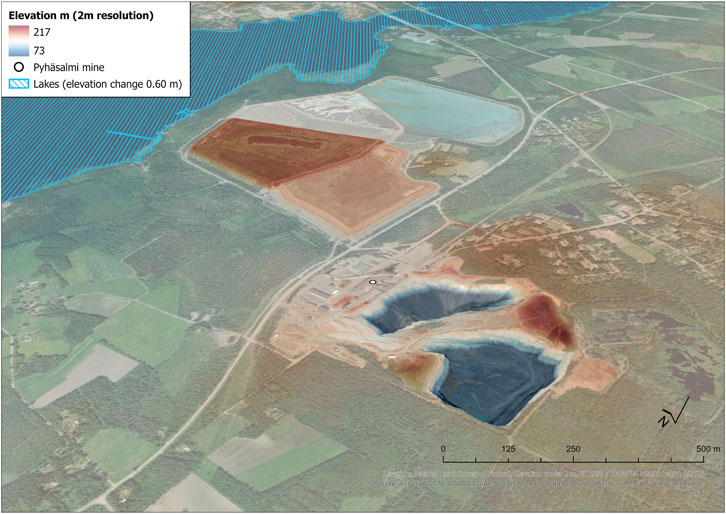
FIGURE 6. Alt Text Pyhäsalmi Digital Elevation Model. Overburden is related to the local topography, and its morphologic changes can be mapped and monitored with high resolution and accuracy to provide a stable environment for underground measurements—analysis and figure created by the fourth author.
Located a few kilometers west of the mine, Lake Pyhäjärvi spans 122 km2 with an average depth of 6.3 m and a maximum of 27 m. Its water level is stable and controlled, with an average annual maximum of 139.74 m over 61 years (1961–2022), a recorded maximum of 139.93 m, and a minimum of 139.42 m. The observed and predicted water levels are publicly available via a data dashboard provided jointly by the Finnish Environment Institute, the ELY Centers, the Finnish Meteorological Institute, and the Flood Centre in collaboration with water sector expert organizations [34]. The nearby small lake Komujärvi is characterized as shallow. See Figure 7 for the distances to topograhic anomalies including the water bodies Lake Pyhäjärvi and Lake Komujärvi.
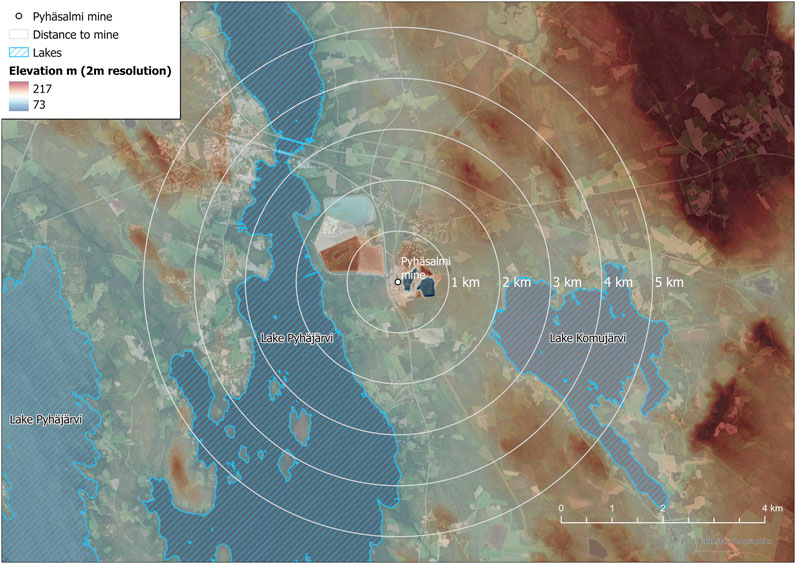
FIGURE 7. Alt Text Lakeside. The geography of the nearest water bodies near the Pyhäsalmi Mine. The surface level of Lake Pyhäjärvi varies by less than a meter as it has been regulated. Similarly, Lake Komujärvi, which flows into Lake Pyhäjärvi, has minor water level variations—the analysis and figure were created by the fourth author.
In winter, a snow layer, typically about 40–60 cm thick, forms a fourth type of overburden [35]. The processes capable of causing alterations in the average densities of natural materials in Pyhäsalmi include the movements of underground water utilizing the fractures in bedrock, fluctuation of the water table within the soil overburden (where it surmounts the soil, it pools), and the seasonal [36]appearance of snow cover.
High-energy neutrons generated by muons pose a challenge for low-background experiments, necessitating accurate muon flux measurements to estimate neutron flux underground. From 2000 to 2005, cosmic-ray-induced muon flux was measured at seven different depths, see Figure 8 [7]. The analysis treated all muons similarly, without distinguishing between vertical and non-vertical directions. The average rock density is 2.85 g/cm3, which was used to convert vertical depth into meters of water equivalent. Effective depths at 210 m and 400 m levels, located beneath the 100-m-deep open pit, were calculated using simulations to reflect flat surface geometry, as shown in Figure 8. Other levels, not under the open pit, were unaffected. Detailed measurement methods are in Ref. [7]. For comparisons of maximum overburden with other laboratories, see Figure 2 in Ref. [24].
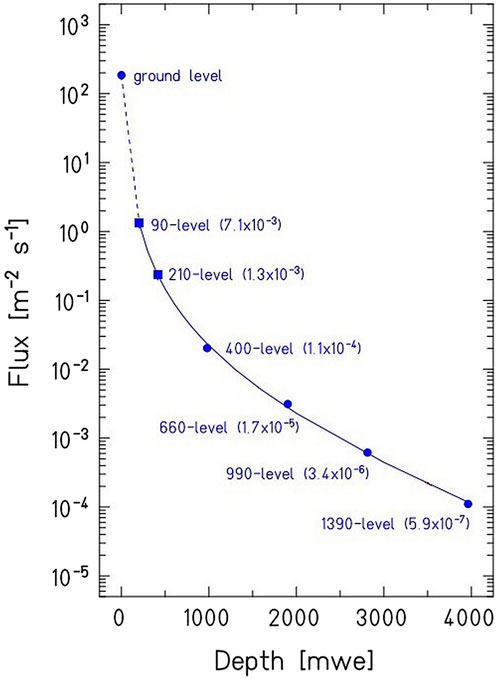
FIGURE 8. Alt Text Muon Flux. The measured muon flux at various levels of the mine. The corresponding reduction of the flux in parentheses compared with the flux at the surface. The deepest surveyed level was at 1,390 m (4,000 m.w.e). Lab 2, e.g., is located at a level of 1,436 m (∼4,100 m.w.e.). For comparison, the depth of the Laboratori Nazionali del Gran Sasso (LNGS) underground laboratory, which hosts multiple particle physics experiments, is 3,800 m.w.e [7,37]. Published with the permission of the author.
Since these measurements date back to the early 2000s, updated muon flux measurements and overburden characterization are needed. This is particularly important considering potential changes in the rock mass density structure in the new mine (between 990 and 1,436 m) due to extraction and backfilling activities in the mining galleries.
The Pyhäsalmi ore deposit belongs to the Volcanogenic Massive Sulphide (VMS) class, originating from submarine volcanism. The Pyhäsalmi VMS deposit is around 1.93–1.92 billion years old [23]. Initially a horizontal sequence, the deposit and surrounding country rocks form a nearly vertical stack due to the Svecofennian Orogeny, a mountain-building event that altered their orientation. During this orogeny, the original marine volcano-sedimentary basin was closed, aligning with the natural sequence of events induced by plate tectonics. The Svecofennian Orogeny also played a significant role by facilitating the generation of magmatic rocks that intruded the original volcano-sedimentary sequence. Some of these intrusive rock bodies, such as pegmatites, may locally contain enriched quantities of U-bearing minerals. See, e.g., Table 10 from the Site characterization and data Callio Lab report1 of the EUL project [38].
Before mining, the ore deposit at Pyhäsalmi contained significant amounts of chalcopyrite (copper), sphalerite (zinc), and pyrite (sulphuric acid) in a near-vertical formation. Traces of these minerals still exist around the underground laboratories. The surrounding rock mass is not uniform in density or radiation properties due to varying rock types and the presence of tunnels and voids.
The mine has an Integrated Seismic System (ISS) for microseismic monitoring, covering production areas from 810 m to 1,425 m. The applicable measuring range is from −2 to 2 on the local magnitude scale (ML). The network consists of geophones with a characteristic frequency of 4.5 Hz capable of detection in a 3–2000 Hz range, allowing for identifying minimal seismic events. Each geophone is linked to a seismometer that converts weak voltage pulses into digital signals, which are then sent to an above-ground server. This server analyzes the data, correlating events across geophones based on timing, automatically pinpointing seismic occurrences, and storing them in a database. The monitoring operates on a trigger system, where the seismometer continuously receives signals but only records data when a predefined signal-to-noise threshold is surpassed.
Weekly data is available online for mine personnel, showing all events (magnitude, location, time) from the past 14 days. More in-depth monthly seismic reports from Australia’s Institute of Mine Seismology (IMS) are provided to the mine. According to internal private communications with Pyhäsalmi Mine Oy, in 2021, when underground mining was still ongoing, the total number of recorded seismic events averaged around 95 per week. Any events larger than 0 ML were singled out; only 10 were recorded out of almost 5,000 yearly events.
Since underground mining ceased in August 2022, including all related tunneling and blasting activities, there has been a notable decrease in seismic events. According to Pyhäsalmi Mine Oy’s 2023 data, seismic events have dropped to a weekly average of seven, marking over a 90% reduction from 2021. It is yet to be determined what the final level of seismic activity will be or if it has already stabilized. The current geophone network, focused mainly on areas active from 2001–2022, could be expanded to cover the entire mine infrastructure, especially considering the planned pumped hydro storage construction. A comprehensive review and potential enlargement of the seismic monitoring network are under consideration.
Rare-event searches necessitate significant rock overburden for shielding against cosmic rays and require deep underground laboratories to maintain low background conditions. Natural background radiation (NBR) can arise from various sources, including surrounding rock, concrete, building materials, equipment, and air.
During Laguna and Laguna LBNO design studies, a numerical study was conducted on the nuclear reactor-induced reactor antineutrino background at different underground laboratories, from which four are selected here as examples: Callio Lab, Canfranc, Frejus, and Boulby. The background calculations were made for the LENA (Low Energy Neutrino Astronomy) detector and are presented in Ref. [39].
The Terrestrial Neutrino Unit (TNU) is one neutrino flux-induced event per 1032 protons (∼1 kiloton of liquid scintillator) per year. The values for 2014 load factors for the above sites were 72.4 ± 3.1, 222.3 ± 8.4, 550.6 ± 19.5 and 1,005 ± 119 TNUs, respectively [39]. These numbers are slightly higher than the ones presented in Ref. [40]. In 2014, there were four nuclear reactors in Finland, two in Olkiluoto (TVO-1 and TVO-2) with nominal thermal power of 5.0 GW and Loviisa 3.0 GW thermal power. The TVO-3, now operational, with 4.3 GW thermal power, is estimated to add 10% to the Pyhäsalmi reactor antineutrino flux. Olkiluoto and Loviisa sites are roughly 360 km away from Pyhäsalmi. Calculations and TVO-3 estimates are based on Ref. [39].
For more up-to-date reactor antineutrino datasets, visit the website A reference worldwide model for antineutrinos from reactors at https://www.fe.infn.it/antineutrino/. It updates the 2015 published Reference worldwide model for antineutrinos from reactors [40]. It provides updated data on Signal in the Low Energy Region (2003–2021), The worldwide map of reactor antineutrino signals (2003–2021), and Predicted reactor antineutrino signals (2013 reactor conditions).
The BSUIN project [41] developed and tested a method for Natural Background Radiation (NBR) measurements in underground labs, ensuring replicability and comparability across different labs. This approach, applied in Lab 2 and Lab 5, included measuring gamma-ray background, in-air radon concentration, and both thermal and fast neutron background. For detailed information on NBR characterization in BSUIN’s underground labs, including Callio Lab, see the project’s final reports on activity A2.22. Lab 2, located at level 1,436 m, consists of Hall 1 (about 700 m³) and Hall 2 (around 1,000 m³) for experiments. Air flows from the elevator shaft into the labs at 10 m³/s, first passing through an air filtration unit. The labs have concrete floors and 5–10 cm thick shotcrete walls. Designed as a multipurpose facility with a low-muon background, its initial use was for underground physics, specifically the C14 experiment, and later for circular economy and underground food production research.
NBR measurements were initially carried out at Lab 2, then at Lab 5. In Lab 2, local NBR was influenced by the radioactivity of the nearby rock and lab hall coating. The thermal neutron flux was assessed using Neutron helium proportional counters (type ZDAJ NEM425A50), sensitive to thermal neutrons, showing a peak at 764 keV. The thermal neutron flux recorded was 1.73 ± 0.10 × 10−5 cm−2 s−1. The gamma-ray background was measured with a portable, liquid nitrogen-cooled HPGe detector (Canberra Industries, Inc.), covering a range of 7 keV to 3.15 MeV. The gamma-ray flux was 12.7 ± 1.5 cm−2 s−1, with a dose of 0.158 ± 0.029 μSv/h. Radon concentration in the air, measured using a Rad7 detector (Durridge Company, Inc.), was 213.3 Bq/m3 ± 11%. Radionuclide analysis of surrounding rock, concrete, and water samples was also conducted. At Lab 5, liquid organic scintillators measured the flux of fast neutrons (0–1.5 MeV) at 37.5 × 10−7 cm−2 s−1, and the neutron flux above 25 MeV was below 0.6 × 10−7 cm−2 s−1 [23,42].
Differences in background radiation were observed between Lab 2 (1,430 m) and Lab 5 (1,410 m), as evidenced by varying NBR levels. Gamma-ray background (GRB) measurements using a low-background HPGe gamma spectrometer with 100 mm lead shielding revealed distinct contrasts. In Lab 2, the GRB showed total integrated counts of 0.095 s−1 kg−1 ± 0.03 s−1 kg−1 (closed lid) in the 40 keV to 2.7 MeV range, significantly higher than Lab 5, which recorded 0.028 ± 0.0007 s−1 kg−1 in the same range. Open lid measurements were approximately 20 s−1 kg−1 in Lab 2 and around 10 s−1 kg−1 in Lab 5. This difference is attributed to local geology and construction materials variations, as Lab 5’s area was built earlier than Lab 2. Table 1 details the radionuclide activities in the materials of both labs [27,28]. Figure 9 shows the HPGe detector measured GRB from Lab 2.
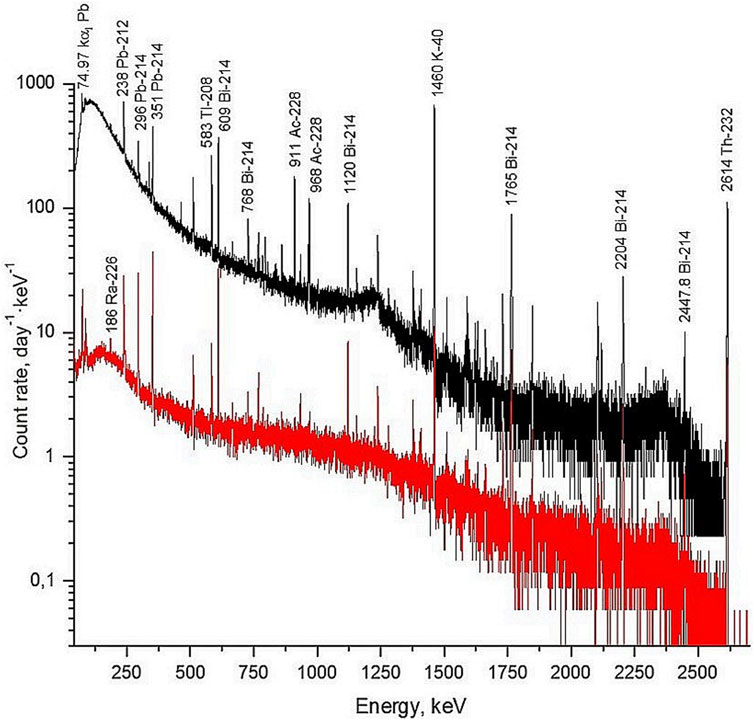
FIGURE 9. Alt Text Gamma-Ray Background Spectra At Lab2. During the Interreg Baltic Sea Region Programme funded BSUIN and EUL projects, detailed GRB measurements were conducted with a dedicated HPGe detector setup, both with the shield open (black) and closed (red) [28]. Published with the permission of the author.
Lab 2’s shotcrete coating shows higher specific activities of natural nuclides, with noticeable differences between wall shotcrete and floor concrete. This underscores the need for thorough screening of building materials in low-background laboratories. While crucial for such facilities, some screening is also advisable in general construction, especially with the trend of using industrial waste in materials like concrete, especially if the materials are to be used in habitats or more permanent working areas.
Lab 5, located on the main level, benefits from more efficient air ventilation compared to Lab 2 (see Figure 10). This is evident from the radon concentration levels: approximately 213 Bq/m3 in Lab 2 and about 22 Bq/m3 in Lab 5. Lab 5 receives fresh air from the surface, with fans blowing 130 m3/s down to the main level, stabilizing air quality and minimizing annual fluctuations. While Lab 2 used additional air filtering for dust removal, Lab 5 did not require such methods. Both labs implemented dust shielding with mechanical structures and flushing with technical air or nitrogen. The low radon levels observed are notable, demonstrating that effective ventilation can achieve low concentrations underground. Callio Lab also has a 20-tonne, 5′ lead-lined sea container for additional shielding.
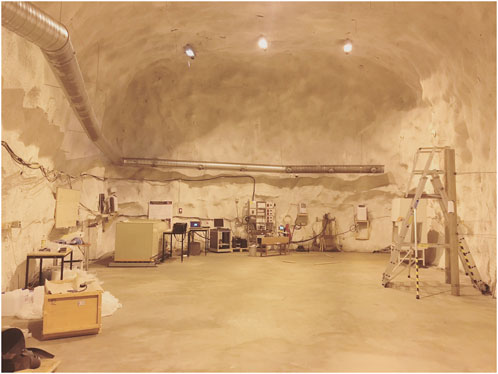
FIGURE 10. Alt Text Lab 2 with the C14 experiment is still in place. Lab 2 is the largest of the Labs developed to host various types of experiments at a depth of 1,436 m. The gallery is a former mine tunnel transformed into a research facility. Since C14 Lab 2 has been used for underground cricket farming and a site for underground rescue training and published with permission.
For the development of a low-background facility at Callio Lab, Lab 5 on the main level is the optimal location due to its NBR suitability. Lab 5, a former central underground storage space of about 3,000 m³, is larger than Lab 2’s 800 m³. It is easily accessible, with just a 3-min elevator ride and a 2-min walk. Large materials can be transported directly into Lab 5 through the incline tunnel, with available lifting equipment for unloading. In contrast, Lab 2 would require upgrades, including new floor and wall coatings and an improved air ventilation system [28].
In characterizing the NBR, it is essential to recognize that no single measurement fully describes an underground infrastructure. Factors like overburden (muon flux), local geology, construction materials (affecting gamma rays and neutron background), and ventilation (radon levels) significantly influence the NBR characteristics of each hall. Therefore, measurement approaches, like those in the BSUIN project, must be thoroughly detailed technically and in terms of location.
The initiative taken at Callio Lab has been and still is very multidisciplinary. The topics range from original underground physics to mining, Earth Observation, environmental and production monitoring of the mine, underground and surface safety, deep geothermal pilots, and underground simulated GNSS positioning. Despite the current project assortment having a limited scope for physics activities, these projects have kept Callio Lab operational. The feasibility of conducting physics experiments at the Pyhäsalmi mine site, acknowledged since 1999, remains unchanged.
The terrain encompassing the mine’s surface and its immediate vicinity is predominantly flat. For the Pyhäsalmi mine, notably Lab 2, the overburden is estimated at approximately 4,100 m.w.e., significantly attenuating the muon background. See Figure 10. for Lab 2. This, coupled with the low radon levels and standard natural background radiation in Lab 5, propels the site forward as a promising ground for further development into underground physics and even a low background physics laboratory. The characterization measurements done during the BSUIN and EUL project at Lab 5 demonstrate that the site can be relatively easily transformed into a low background facility. The bedrock is still well understood and excavatable, potentially hosting small, medium, or even large-scale physics experiments, which was confirmed during the Laguna Design studies and extended site investigations [5,43]. The low reactor antineutrino background is also advantageous for locating various neutrino experiments at Callio Lab [39].
The distance from Cern to Pyhäsalmi is 2,300 km, making it a good candidate for accelerator beam-based long baseline neutrino studies, especially linked to open questions in neutrino mass hierarchy and CP violations [44,45]. The long baseline measurements and the 2,450 km baseline magics could determine the mass hierarchy independent from the CP phase [44]. The Laguna Design studies investigated a large-scale Liquid Argon-based Time Projection Chamber called GLACIER [2].
The Callio Lab, as described in its characteristics section, offers a lower reactor antineutrino background compared to other underground laboratories in mainland Europe. This reduced background is advantageous for studying solar, supernova, and geoneutrinos, whose energy regions intersect with those of reactor antineutrinos. During the Laguna era, the LENA detector was identified as a feasible project for implementation in Pyhäsalmi [2].
Low reactor antineutrino background at Pyhäsalmi also benefits geosciences. Geoneutrinos, emitted from β decaying isotopes like U-238 and Th-232 in the Earth, are detectable via inverse beta decay. Although K-40 is a significant emitter, its neutrinos are undetectable. Studying geoneutrinos at Pyhäsalmi would help to estimate the distribution of these isotopes on average on Earth and as a part of a network of geoneutrino detectors, in more detail the mantle and crust, which is essential for understanding Earth’s heat budget and thermal history. Over 99% of the Earth’s internal heat is from the decay of these isotopes, influencing plate tectonics and magnetic field generation. Geoneutrinos offer insights into the Earth’s deep interior, complementing seismic data and overcoming limitations of traditional rock sampling methods [36,39].
Callio Lab could host experiments to detect dark matter particles, which are hypothesized to constitute a significant portion of the universe’s mass. With reduced background noise, the underground setting is ideal for deploying sensitive detectors that search for weakly interacting massive particles (WIMPs) or axions. This has been one of the original options since the dawn of CUPP, but it has also been piloted at Callio Lab with the NEMESIS experiment [46,47]. See, e.g., [47], for more information on the NEMESIS, located at Lab 1, and its successor, NEMESIS1.4, located at Lab 5. See Figure 11 for NEMESIS1.4 at Lab 5.
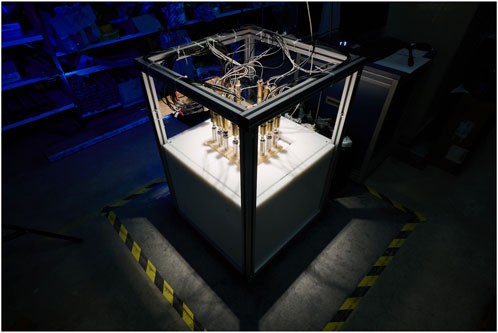
FIGURE 11. Alt Text NEMESIS1.4 At Lab 5. NEMESIS1.4. the pilot experiment for dark matter is located at a depth of 1,410 m in Lab 5. The setup consists of neutron detectors embedded within the lead target of 1,130 kg. The NEMESIS1.4 aims to search for anomalies in high-multiplicity neutron spectra emitted from massive, metallic targets placed deep underground. Photo by S. Trzaska. Published with permission.
Callio Lab’s known geology and structured spaces are ideal for muography, which uses cosmic muons to image Earth’s interior. This environment is suitable for testing and improving muography. Its mine, with various tunnels, is well-suited for muon radiography and tomography, making Callio Lab an ideal location for exploring and advancing muography research. Surface structures can also be used in experiments, benefiting from an average muon flux of ∼150 muons per square meter [48].
Researching gravitational variations in a mine, especially near a potential pumped-hydro energy storage site, presents a valuable chance for applied physics studies. The consistent overburden, minor water level fluctuations in Lake Pyhäjärvi and Lake Komujärvi, and data from the energy storage facility help pinpoint gravitational anomalies. Predictable gravitational changes caused by water movements in the underground pumped-hydro facility make it an ideal site for precise gravimetric studies.
The Atom Interferometric Observatory and Network (AION) project could greatly benefit from this environment. It is a multidisciplinary effort to investigate complex physics phenomena using advanced ultra-cold atom and laser technologies. Ultra-cold atoms, cooled to near absolute zero, allow for highly accurate measurements, aiding in detecting phenomena like ultra-light dark matter and gravitational waves, thus significantly contributing to our understanding of the universe [49].
Ultra-light dark matter lacks interaction with electromagnetic radiation and is detectable only through its gravitational effects. However, gravitational waves, which are space-time ripples from cosmic events like black hole collisions, provide a window into the universe’s dynamic processes. AION aims to precisely utilize these phenomena precisely, exemplifying applied physics [49].
Given the substantial overburden at Callio Lab and the observable local environmental gravitational changes, it emerges as a suitable venue for hosting various developmental phases of AION, whether in horizontal tunnels or vertical shafts, thus presenting a real-world application of applied physics principles in a controlled environment [49].
Despite not receiving governmental funding like other established underground labs, Callio Lab has thrived by supporting science and research through its unique, cost-effective, multidisciplinary approach. With a 4,100 m.w.e. flat overburden, stable bedrock, distance from nuclear reactors, and the capability to expand or excavate new tunnels, Callio Lab is recognized for its potential to host large-scale underground detectors in Finland and Europe, as noted already in the LAGUNA and LAGUNA LBNO design studies.
National and international network support and the University of Oulu’s backing have been crucial in transitioning Callio Lab to a multidisciplinary research infrastructure. This collaboration has yielded successes in various European projects, including H2020 GoldenEye, Horizon Europe MINE.IO, and numerous ERDF projects. While this approach has ensured Callio Lab’s sustainability, it has also impacted long-term infrastructure development, particularly for underground physics. The lab’s future in underground, high-energy, and applied physics depends on the direction and scale of funded projects.
JJ: Conceptualization, Methodology, Visualization, Writing–riginal draft, Writing–review and editing. JP: Visualization, Writing–original draft, Writing–review and editing. MH: Writing–original draft, Writing–review and editing. OK: Conceptualization, Methodology, Writing–original draft, Writing–review and editing.
The author(s) declare financial support was received for the research, authorship, and/or publication of this article. This work has been partially supported by the H2020 project GoldenEye (GA ID: 869398).
The authors declare that the research was conducted in the absence of any commercial or financial relationships that could be construed as a potential conflict of interest.
All claims expressed in this article are solely those of the authors and do not necessarily represent those of their affiliated organizations, or those of the publisher, the editors and the reviewers. Any product that may be evaluated in this article, or claim that may be made by its manufacturer, is not guaranteed or endorsed by the publisher.
1https://bsuin.eu/wp-content/uploads/2022/03/A3.3_report_Site-Description-Callio-Lab_final.pdf
2http://bsuin.eu/wp-content/uploads/2021/01/Final_Report_A2.2.pdf
1. Jämsen T, Elo AM, Kangas J, Mursula K, Peltoniemi J, Usoskin I∼G, et al. A new multilevel experiment MUG for observing muon fluxes underground. Int Cosmic Ray Conf (2001) 3:1250.
2. Trzaska WH, Enqvist T, Joutsenvaara J, Kalliokoski T, Kokko E, Kuusiniemi P, et al. Advantages of locating LAGUNA in Pyhäsalmi mine. Prog Part Nucl Phys (2011) 66(2):463–7. doi:10.1016/j.ppnp.2011.01.052
3. Trzaska WH, Kalliokoski T, Loo K, Maalampi J, Enqvist T, Joutsenvaara J, et al. LAGUNA in Pyhäsalmi. Acta Physica Pol B (2010) 41(7).
4. Nuijten GA. LAGUNA DESIGN STUDY, Underground infrastructures and engineering. J Phys Conf Ser (2011) 308(1):012029. doi:10.1088/1742-6596/308/1/012029
5. Tonazzo A. The LAGUNA-LBNO project. Nucl Part Phys Proc (2015) 265–266:192–4. doi:10.1016/j.nuclphysbps.2015.06.049
6. Jämsen T, Usoskin IG, Räihä T, Sarkamo J, Kovaltsov GA, Jämsén T, et al. Case study of Forbush decreases: energy dependence of the recovery. Adv Space Res (2007) 40(3):342–7. doi:10.1016/j.asr.2007.02.025
7. Enqvist T, Mattila A, Föhr V, Jämsén T, Lehtola M, Narkilahti J, et al. Measurements of muon flux in the Pyhäsalmi underground laboratory. Nucl Instrum Methods Phys Res A (2005) 554(1–3):286–90. doi:10.1016/j.nima.2005.08.065
8. Enqvist T, Föhr V, Joutsenvaara J, Jämsén T, Keränen P, Kuusiniemi P, et al. EMMA: a new underground cosmic-ray experiment. J Phys Conf Ser (2006) 34. doi:10.1088/1742-6596/39/1/125
9. Kuusiniemi P, Bezrukov L, Dzaparova I, Enqvist T, Fynbo H, Inzhechik L, et al. Performance of tracking stations of the underground cosmic-ray detector array EMMA. Astroparticle Phys (2018) 102:67–76. doi:10.1016/j.astropartphys.2018.05.001
10. Enqvist T, Barabanov IR, Bezrukov LB, Gangapshev AM, Gavrilyuk YM, Vyu G, et al. Towards 14C-free liquid scintillator. J Phys Conf Ser (2017) 888:012098. doi:10.1088/1742-6596/888/1/012098
11. Jalas P, Enqvist T, Isoherranen V, Joutsenvaara J, Kutuniva J, Kuusiniemi P. Callio lab, a new deep underground laboratory in the Pyhäsalmi mine. J Phys Conf Ser (2017) 888(1):012156. doi:10.1088/1742-6596/888/1/012156
12. Ahonen L, Ala-Rämi K, Lehtinen U, Leppäharju N, Martinkauppi A. Pyhäsalmen kaivos hiilivapaan lämpöenergiatuotannon mahdollistajana Mikroyrittäjyyden tutkimusryhmä MicroENTRE ja Geologian tutkimuskeskus. Oulu, Finland: University of Oulu (2023).
13. Kietäväinen R, Ahonen L, Kukkonen IT, Niedermann S, Wiersberg T. Noble gas residence times of saline waters within crystalline bedrock, Outokumpu Deep Drill Hole. Finland Geochim Cosmochim Acta (2014) 145:159–74. doi:10.1016/j.gca.2014.09.012
14. Kietäväinen R, Purkamo L. The origin, source, and cycling of methane in deep crystalline rock biosphere. Front Microbiol (2015) 6(JUL):725. doi:10.3389/fmicb.2015.00725
15. Callio P. Edible insects (2023). Available from: https://callio.info/natural-resources-business/edible-insects/ (Accessed December 11, 2023).
16. Puputti J, Holma M, Kotavaara O, Joutsenvaara J, Magyar M. Callio Lab – a GoldenEye field trial site at the Pyhäsalmi mine in Finland. In: EGU general assembly. Vienna, Austria: Copernicus GmbH (2023).
17. GoldenEye. GoldenEye (2021). Available from: http://www.goldeneye-project.eu/ (Accessed December 11, 2023).
18. Elger K, Lauterjung J, Ulbricht D, Cocco M, Atakan K, Bailo D, et al. Implementation of the European plate observing system. Norwich, England, UK: EPOS Infrastructure (2016).
19. Havisto J, Matselyukh T, Paavola M, Uusitalo S, Savolainen M, González AS, et al. Golden AI data acquisition and processing platform for safe, sustainable and cost-efficient mining operations. In: 2021 IEEE International Geoscience and Remote Sensing Symposium IGARSS; July, 2021; Brussels, Belgium (2021). p. 5775–8.
20. European Commission. MINE.IO (2023). Available from: https://ec.europa.eu/info/funding-tenders/opportunities/portal/screen/how-to-participate/org-details/999756982/project/101091885/program/43108390/details (Accessed December 11, 2023).
21. Callio. Callio - mine for business (2021). Available from: https://callio.info (Accessed December 11, 2023).
22. Karhinen S, Huuki H. Private and social benefits of a pumped hydro energy storage with increasing amount of wind power. Energy Econ (2019) 81:942–59. doi:10.1016/j.eneco.2019.05.024
23. Joutsenvaara J, Holma M, Puputti J, Szkliniarz K, Kisiel J. SITE DESCRIPTION AND DATA OF THE CALLIO LAB Site services. Characteristics and Data (2021). Available from: https://bsuin.eu/wp-content/uploads/2022/03/A3.3_report_Site-Description-Callio-Lab_final.pdf.
24. Ianni A. Considerations on underground laboratories. J Phys Conf Ser (2020) 1342(1):012003. doi:10.1088/1742-6596/1342/1/012003
25. Salmelainen J, Ström J, Cristiá S, Hatakka L, Tirinen J, Westerlund G, et al. LAGUNA-LBNO EXTENDED SITE INVESTIGATION AT PYHÄSALMI, Finland Deliverable 9 Site investigation summary (2014).
26. European Commission. Mine.IO consortium. Horizon Europe project MINE.IO (2023). Available from: https://ec.europa.eu/info/funding-tenders/opportunities/portal/screen/how-to-participate/org-details/999756982/project/101091885/program/43108390/details (Accessed December 13, 2023).
27. Pohuliai S, Sokolov A, Gostilo V, Joutsenvaara J, Puputti J. Measurements of gamma-ray background radiation in Pyhäsalmi mine. Appl Radiat Isot (2020) 161:109166. doi:10.1016/j.apradiso.2020.109166
28. Gostilo V, Sokolov A, Pohuliai S, Joutsenvaara J. Characterisation of the natural gamma-ray background in the underground Callio Lab facility. Appl Radiat Isot (2020) 156:108987. doi:10.1016/j.apradiso.2019.108987
29. Joutsenvaara J. Deeper understanding at Lab 2: the new experimental hall at Callio Lab underground centre for science and R & D in the Pyhäsalmi Mine. Master´s Thesis. Finland: University of Oulu (2016).
30. Callio. Callio lab (2021). Available from: https://calliolab.com (Accessed December 11, 2023).
31. Callio. Callio FUTUREMINE (2022). Available from: https://callio.info/2017/wp-content/uploads/Callio-FutureMINE-press-release-1.11.2022.pdf (Accessed December 11, 2023).
32. Joutsenvaara J, Holma M, Kotavaara O, Puputti HJ. Callio Lab - the deep underground research centre in Finland, Europe. J Phys Conf Ser (2021) 2156(1):012166. doi:10.1088/1742-6596/2156/1/012166
33. National Land Survey of Finland. National land survey of Finland (2023) elevation model 2 m. Helsinki, Finland: National Land Survey of Finland (2023).
34. FMI. Water body predictions - vesistöennusteet: pyhäjoen vesistö alue- Pyhäjärvi -Junttiselkä (2023).
36. Sammon LG, McDonough WF. Quantifying Earth’s radiogenic heat budget. Earth Planet Sci Lett (2022) 593:117684. doi:10.1016/j.epsl.2022.117684
37. Bellini G, Benziger J, Bick D, Bonfini G, Bravo D, Avanzini MB, et al. Cosmic-muon flux and annual modulation in Borexino at 3800 m water-equivalent depth. J Cosmology Astroparticle Phys (2012) 2012(05):015. doi:10.1088/1475-7516/2012/05/015
38. Konieczna-Fuławka M, Szumny M, Fuławka K, Jaśkiewicz-Proć I, Pactwa K, Kozłowska-Woszczycka A, et al. Challenges related to the transformation of post-mining underground workings into underground laboratories. Sustainability (2023) 15(13):10274. doi:10.3390/su151310274
39. Loo K. Extending physics potential of large liquid scintillator neutrino detectors (2016). Available from: https://jyx.jyu.fi/bitstream/handle/123456789/52317/978-951-39-6812-0.pdf.
40. Baldoncini M, Callegari I, Fiorentini G, Mantovani F, Ricci B, Strati V, et al. Reference worldwide model for antineutrinos from reactors (2015). Available from: www.fe.infn (Accessed December 12, 2023).
41. Joutsenvaara J, BSUIN - Baltic Sea underground innovation network. EGUGA (2020):11212 (Accessed December 12, 2023).
42. Polaczek-Grelik K, Walencik-Łata A, Szkliniarz K, Kisiel J, Jȩdrzejczak K, Szabelski J, et al. Natural background radiation at lab 2 of Callio lab, Pyhäsalmi mine in Finland. Nucl Instrum Methods Phys Res A (2020) 969:164015. doi:10.1016/j.nima.2020.164015
43. Angus D, et al. The LAGUNA design study-towards giant liquid based underground detectors for neutrino physics and astrophysics and proton decay searches. In: European strategy for future neutrino physics Proceedings, Workshop; October, 2009; Geneva, Switzerland (2009).
44. Agarwalla S, Agostino L, Aittola ag M, Alekou A, Andrieu B, Angus af D, et al. Published for SISSA by Springer the mass-hierarchy and CP-violation discovery reach of the LBNO long-baseline neutrino experiment the LAGUNA-LBNO collaboration. JHEP (2014) 94.
45. Raut SK, Singh RS, Uma Sankar S. Magical properties of a 2540 km baseline superbeam experiment. Phys Lett B (2011) 696(3):227–31. doi:10.1016/j.physletb.2010.12.029
46. Peltoniemi J, Group C. Underground physics in the Pyhäsalmi mine. Phys Scr (2001) 2001(T93):102.
47. Trzaska WH, Barzilov A, Enqvist T, Jedrzejczak K, Joutsenvaara J, Kasztelan M, et al. NEMESIS setup for indirect detection of WIMPs. Nucl Inst Methods Phys Res (2022) 1040:167223. doi:10.1016/j.nima.2022.167223
48. Joutsenvaara J, Holma M, Hynynen I. Thoughts about an ideal validation environment for muography applications. J Adv Instrumentation Sci (2022) 2022:2022. doi:10.31526/jais.2022.282
Keywords: Callio lab, research infrastructure, underground physics, underground laboratory, multidisciplinary
Citation: Joutsenvaara J, Puputti J, Holma M and Kotavaara O (2024) Callio lab: an underground and above ground,laboratory—overview and prospects for high energy and applied physics. Front. Phys. 12:1317659. doi: 10.3389/fphy.2024.1317659
Received: 10 October 2023; Accepted: 03 January 2024;
Published: 18 January 2024.
Edited by:
Sean M. Paling, United Kingdom Research and Innovation, United KingdomReviewed by:
Olga Gileva, Institute for Basic Science (IBS), Republic of KoreaCopyright © 2024 Joutsenvaara, Puputti, Holma and Kotavaara. This is an open-access article distributed under the terms of the Creative Commons Attribution License (CC BY). The use, distribution or reproduction in other forums is permitted, provided the original author(s) and the copyright owner(s) are credited and that the original publication in this journal is cited, in accordance with accepted academic practice. No use, distribution or reproduction is permitted which does not comply with these terms.
*Correspondence: Jari Joutsenvaara, SmFyaS5Kb3V0c2VudmFhcmFAb3VsdS5maQ==
Disclaimer: All claims expressed in this article are solely those of the authors and do not necessarily represent those of their affiliated organizations, or those of the publisher, the editors and the reviewers. Any product that may be evaluated in this article or claim that may be made by its manufacturer is not guaranteed or endorsed by the publisher.
Research integrity at Frontiers

Learn more about the work of our research integrity team to safeguard the quality of each article we publish.